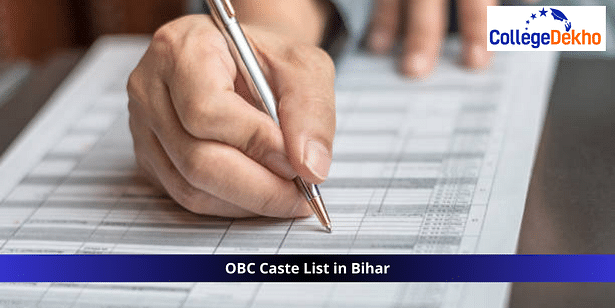
OBC Caste List in Bihar: In line with the Indian Constitution, Other Backward Classes or OBCs are classified as socially and educationally backward classes (SEBC), and the government of India is tasked with ensuring their advancement in these areas. As an example, OBCs are entitled to 27% reservations in higher education and public sector jobs. As you may know, Bihar is one of the largest Indian states in terms of area and population. It has around 13 crore population in total with 200 castes residing.
About 33 castes in Bihar are classified as OBC 1, or Other Backward Classes. On the other hand, nearly 113 castes come under the Economically Backward Class or Extremely Backward Class or OBC 2. Following the Other Backward Classes, who make up 27.13% of the population, the Extremely Backward Classes make up the largest social category in Bihar, with 36% of the overall population. With a combined population of little over 13.07 crore, the two groups make up 63% of the state's entire population. In this article, we will discuss the OBC caste list in Bihar along with other benefits for OBC communities.
Related Articles:
OBC Caste List in Bihar: Updates and Changes
Based on the Bihar Caste Survey Report, the Bihar government has decided to raise the job reservation for marginalised people from 50% to 65%. With this rise and an additional 10% quota for economically disadvantaged groups, Bihar's overall quota now stands at 75%. Based on the population share of each category, the new quota allocation is as follows: 20% goes to Scheduled Castes, 2% to Scheduled Tribes, and 43% goes to backward and extremely backward classes. The caste-based headcount supports this government action, which it is taking in an attempt to stave off legal challenges.
Related Articles:
OBC Caste List in Bihar: Updated List
As discussed, the OBCs have witnessed social and economic mobility. The following table represents a comprehensive OBC caste list in Bihar.
Abdal | Agariya | Aghori |
|---|---|---|
Amaat | Kasab (Kasai) (Muslim) | Kewat, Keot |
Kadar | Kaivartta/ Kaibartta | Kalandar |
Kaura | Kawar | Kochh |
Korku | Kumarbagh Pahadia | Kurmi |
Kurmi (Mahto) (in Chhotanagpur Division only) | Kagzi | Kanu |
Kamar (Lohar, Karmkar, Visvakarma) | Kushwaha (Koeri) | Kapadia |
Kosta, Koshta | Khatik | Khangar |
Khatwa, Khatwe, Khadwar (only in the districts of Sivan & Rohtas) | Khetauri, Khatauri | Khelta |
Godi (Chhava) | Gaddi | Gandarbh or Gandharb |
Gangai (Ganesh) | Gangota, Gangoth | Gorh, Gonrh (only in the districts of Saran & Rohtas) |
Barai | Gulgaliya | Goud |
Ghatwar | Chik (Muslim) | Chain |
Chayeen | Chapota | Chandrabanshi (Kahar) |
Churihar (Muslim) | Chanou | Jogi (Jugi) |
Tikulhar | Dafali (Muslim) | Dhekaru |
Tanti (Tatwa), Tati, Tatin | Turha | Tamariya |
Tiyar | Tamoli, Tamboli | Teli |
Tharu | Devhar | Dhanuk |
Dhobi (Muslim) | Dhunia (Muslim) | Dhamin |
Dhankar | Dhimar | Nai |
Nat (Muslim) | Nunia, Nonia | Namshudra |
Naiya | Nalband (Muslim) | Pamaria (Muslim) |
Prajapati (Kumhar) | Pandi | Pinganiya |
Parya | Pradhan | Pahira |
Pal (Bherihar-Gaderi) | Gaderia | Bekhada |
Bagdi | Bari | Beldar |
Bind | Barhai (Viswakarma) | Badhai |
Importance of the OBC Caste List
In Bihar, according to a government poll, the majority of people live as EBCs, with 112 castes, accounting for 36.01% of the total population. The next largest group of people are OBCs, with 29 castes and a 27.12% share. Out of all the OBC castes, the Yadavs hold the largest percentage at 14.26%. The percentage of people who belong to Scheduled Castes is 19.65%, whilst the percentage of people who are not reserved is 15.52% of the total population.
OBCs, as opposed to even the higher castes, have the most rapid intergenerational mobility, based on a recent International Monetary Fund analysis. In contrast to the Dalits, they became landlords and landowners. As a result of the Mandal Commission's implementation in 1990, they were able to access formal economic possibilities, higher education, entry into the formal sector, etc.
Criteria for Inclusion in the OBC List
Before the Mandal Commission report's proposal of implementing a reservation policy in government positions and educational institutions, there was a significant discrepancy between different castes and groups designated as Other Backward Class. A portion of Other Backward Castes held a significant amount of land and hired Scheduled Castes (SC) as agricultural labourers, even though the majority of this group was exceedingly backward. Due to their substantial land holdings, the Kurmis, Yadavs, and Koeris — referred to as "upper-OBC" — were prosperous in several North Indian states. After India gained its freedom, the Zamindari system was abolished, which gave many of the people living in these villages the title of landlords.
Related Articles:
Benefits for OBC Communities
Considering the OBC caste list in Bihar comprised both Muslims and Hindus, the movement was commonly called a "secular upsurge" or the "second democratic upsurge". They were considered by some academics to be "bullock capitalists" because they were landowners but also socially regressive. Because of this, they were able to undermine the viability of left-wing class politics in India and enhance the centrist nature of Indian politics. Furthermore, because of their low caste status, they rejected the majoritarian confessional politics of the Right. Numerous initiatives and strategies are being carried out by the federal and state governments to improve the status of OBCs. The OBC caste list in Bihar benefits from several factors, including:
There is a 27% reservation quota for seats at government institutes like the IIMs and IITs, as well as posts like IPS, IAS, and so forth.
The maximum age limit for many exams, including the UPSC Civil Services Exam, has changed. On the other hand, there are fewer limitations on the number of test administrations. For cut-off marks, there is a leniency.
Related Articles:
Crosschecking whether your class belongs to the OBC caste list in Bihar is essential to reap the complete benefits of beneficiaries offered by the government of India. Since the state administration has also accepted a 10% quota for the economically disadvantaged segment groups, as declared by the Centre, the overall quota for the OBC caste list in Bihar would now be 75%.
Are you feeling lost and unsure about what career path to take after completing 12th standard?
Say goodbye to confusion and hello to a bright future!

FAQs
No, the Indian government has not made any recent additions to the OBC caste list in Bihar. As of 2024, a total of 133 OBC caste/community people reside in Bihar. Every year, the Bihar government carries out a caste census to introduce new schemes for the benefit of people.
The importance of the OBC caste list in Bihar is for people to understand their collective population and the rights offered by the Indian government. With this, they can take advantage of the educational schemes and other beneficiaries.
The OBC population of Bihar is 63% overall. Following the Other Backward Classes, who make up 27.13% of the population, the Extremely Backward Classes make up the largest social category in Bihar, with 36% of the overall population.
The OBC caste list in Bihar includes Chayeen, Chapota, Pandi, Pinganiya, Pradhan, Pahira, Abdal, Amaat, Kadar, Kaura, Korku, Kaivartta/ Kaibartta, Kalandar, Kawar, Kochh, Kumarbagh, Pahadia, Kurmi, Kagzi, Kanu, and more.
Was this article helpful?


















Similar Articles
Documents Required to Fill SET 2025 Application Form - Photo Upload, Specifications
How to Contact BSCC Support for Loan Status Issues
Bihar STET 2025: Exam Dates (Soon), Registration (April), Admit Card, Exam Pattern, Syllabus, and Result
TNPSC Group 4 Recruitment 2025: Exam Dates, Registration, Result, Cut off, Selection Process, Vacancies
Difference Between WB Student Credit Card and Bank Loans
HBSE Class 11 Registration Form 2026 - Check Haryana Board 11th Registration Form Dates, Fees